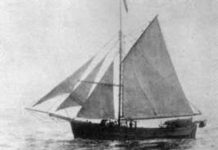In 1632, following the reclamation of France’s North American colonies from England, the French court decreed that the Jesuit order would take control of all missionary work among the native peoples of New France. No group was better qualified for this task. The Jesuits were all men of strong character, determined and disciplined, and zealous in their desire to convert pagans to Christianity. The perils they faced in pursuing their goal amongst hostile tribes in the North American wilderness held no fear for them. Martyrdom was regarded as a highly desirable fate: indeed, the Jesuits became convinced that martyrs were essential to the ultimate success of their mission.
The first group of Jesuit priests returned to New France in the summer of 1632. Father Isaac Jogues, diminutive and delicate in appearance, was a member of the second company that arrived in 1635. The following year, he travelled to the homeland of the Huron people near Georgian Bay to join the missionary effort already underway there. Jogues laboured in Huronia until the summer of 1642, when he departed for Quebec on official business at the request of the Jesuit Superior. In addition to an escort of Hurons, he was accompanied by Rene Goupil, a young surgeon, and carpenter Guillaume Couture.
Capture and Escape
Their journey proceeded without incident until they reached the St. Lawrence River. War parties from the Five Nations of the Iroquois Confederacy (Cayuga, Mohawk, Oneida, Onondaga, Seneca) lurked within the countryside that bordered the river, attacking the French settlers and their Indian allies at every opportunity. As Jogues and his companions neared Lake St. Pierre, their canoes hugging the shoreline in an attempt to conceal their presence, they were ambushed by a group of forty Mohawks. Most of the Hurons were killed in the attack; the three Frenchmen were taken prisoner and carried off to the Mohawks’ village in their country south of Lake Ontario. Once there, Couture was adopted by the tribe and Goupil was slain. Jogues was tortured continuously for several days: his finger nails were torn out, his hands were pulverized into shapeless stumps, and the flesh on his arms was sawn through to the bone with ropes. He was then enslaved by his captors.
He was saved by a group of Dutch traders who discovered him while visiting their Mohawk allies in 1643. They spirited Jogues out of the village, then down the Hudson River to their main post at Albany. He was eventually put on a ship bound for France, where he was welcomed in fervent acclaim and spent many months recovering from his ordeal. However, believing that duty called, he returned to New France in the spring of 1644.
Mission of the Martyrs
In July 1645, the Iroquois concluded a peace treaty with the French, Hurons and Algonquins. Once the treaty was formalized, the Iroquois asked for missionaries to be sent to their villages. Since Father Jogues had acquired some knowledge of the language and customs of the Mohawks during his captivity, he was selected to go to their country and establish a mission, to be called Mission of the Martyrs, among them. Initially, he enjoyed success in his endeavour. The Mohawks welcomed the little priest and appeared attentive to his preaching. In the autumn of 1646, when he departed to make a report to his superiors in Quebec, he left a wooden box with the tribe as a pledge that he would return.
His gesture of goodwill had tragic consequences. The Mohawks were the most belligerent of the Five Nations. They had joined the peace of 1645 reluctantly and one faction within the tribe, the Bear clan, was determined to resume fighting. Following Jogues’ departure, the Bears’ medicine men claimed he had placed evil spirits within the box, which were responsible for the famine the tribe was enduring. Their savage audience was quite willing to believe these accusations, and was soon lusting for revenge.
While Jogues was at Quebec, the Jesuit leadership deliberated on the future of the Mission of the Martyrs. Initially, it was decided Jogues would remain in Quebec throughout the winter months but, within days, that decision was reversed and Jogues was instructed to return to the Mohawks expeditiously. Though he obeyed without hesitation, the priest had a premonition regarding the fate that awaited him. In a letter to a friend in France, he wrote Ibo et non redibo (“I go, but I shall not return”).
Martyrdom
Jogues set off with one French companion, a young servant named Lalande, and an escort of Hurons. En route, they encountered a group of friendly Mohawks who warned them it was not safe to proceed. The Hurons promptly fled, but Jogues and his aide continued on. Shortly thereafter, they were seized by a Bear clan war party and taken to their village. There, both men were stripped, tied to stakes and beaten. Ribbons of flesh were torn from the priest’s back.
In the evening, the badly-injured Jogues was summoned to the lodge of the Bear chief. Knowing that refusal would mean instant death, he immediately complied. As he entered the lodge, a Mohawk warrior who had been standing just inside leapt upon him. The Mohawk drove his tomahawk through Jogues’ skull into his brain, then hacked his shattered head free of his body. The following morning, the faithful Lalande was dispatched in the same manner. The heads of both men were then triumphantly displayed atop the village’s palisade.
The valiant little priest had become the first martyr of the Jesuits’ mission in New France. He would eventually be canonized on June 29, 1930
Sources:
- Costain, Thomas B. The White and the Gold: The French Regime in Canada. Doubleday & Company, Inc., Garden City, New York, 1954.
- Eccles, William J. The Canadian Frontier: 1534-1760. Holt, Rinehart & Winston Inc., Toronto, 1969.
- Hayes, John F. Wilderness Mission. The Ryerson Press, Toronto, 1969.
- Jury, Wilfred and Jury, Elsie McLeod. Sainte-Marie Among the Hurons. Oxford University Press, Toronto, 1954.







